Top 10 Spring Vegetables for A Healthy Microbiome
Recipe Key
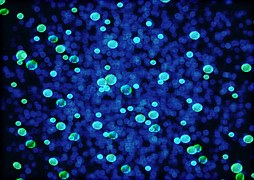 Studies are coming out all the time about the importance and influence the microbiome has on almost every aspect of our health and happiness.
Studies are coming out all the time about the importance and influence the microbiome has on almost every aspect of our health and happiness.
This time of year, the weather, harvests, and microbes are making dramatic changes.
Within our bodies, the winter microbes that are geared for keeping the body warm and digesting heavier foods are transitioning to spring microbes that have a new purpose – fat burning, natural weight loss, stable mood and renewed energy for the full year ahead.
 Did you know in winter when there are limited greens deer have the specific microbes needed to digest the bark available that time of year?
Did you know in winter when there are limited greens deer have the specific microbes needed to digest the bark available that time of year?
But when spring comes the microbes change as they begin to chew on surface roots called rhizomes and the sprouts that begin to emerge. Their entire inner micobiome changes. It is the same with us.
By eating in harmony with the seasons you transition your inner ecosystem. You stay strong, healthy, energized and focused.
Here are my favorite vegetables seasonally available in spring. Even though some of them may be found year round, your body will really love eating them this time of year.
1. Peas
 Peas are one of my favorite spring vegetables. Now is the time to honor peas. Since they thrive in the cool changing weather of spring they are among the first vegetables we harvest.
Peas are one of my favorite spring vegetables. Now is the time to honor peas. Since they thrive in the cool changing weather of spring they are among the first vegetables we harvest.
Sweet peas are one of the most easily digestible beans. They are high protein with just under 9 grams of protein per cup. This is not as much as edamame with 22 grams per cup but way more than broccoli with only 2.6 grams per cup.
As your body is naturally detoxing in the spring, high fiber peas cleanse toxins out of the colon and improve digestive strength.
2. Asparagus
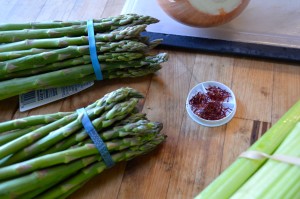 As far as I am concerned there is no greater treat in the spring than local asparagus.
As far as I am concerned there is no greater treat in the spring than local asparagus.
Asparagus contains inulin which is a carbohydrate that provides our digestive tract with some unique health benefits. Unlike most other carbs inulin doesn’t get digested in the first part of the digestive tract, instead it passes undigested all the way to the large intestine. There it feeds and sparks production of certain beneficial bacteria like lactobacilli and bifidobacteria that help nutrient absorption and lower the risk of colon cancer.
It’s great for bloating or if you’re feeling a little puffy and high in fiber, vitamin A, and vitamin K.
Asparagus can be steamed, sautéed, roasted or grilled. They are best eaten cooked but if you grow your own and they are really fresh a shaved raw asparagus salad can be delightful.
3. Beets
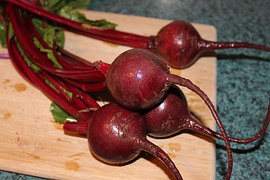 Beets stimulate the production of bile and decongest the liver. Beets are rich in betaine, which restores liver cell function and protects the liver and bile ducts. Betaine can actually help protect the liver from the impact of alcohol, making beets (or betaine) an excellent food for detoxification.
Beets stimulate the production of bile and decongest the liver. Beets are rich in betaine, which restores liver cell function and protects the liver and bile ducts. Betaine can actually help protect the liver from the impact of alcohol, making beets (or betaine) an excellent food for detoxification.
Beets can be eaten raw or cooked. Grate then into salads or add to smoothies. They can be roasted, boiled or sautéed. Don’t throw out the leaves, sauté or steam them. They are in the same family as spinach and just as nutritious.
4. Watercress
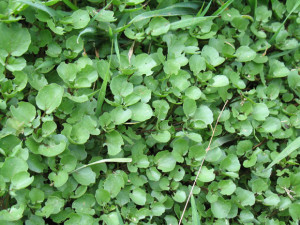 Watercress is nutrient dense, packed with micro-nutrients and antioxidants. While many green vegetables like spinach contain oxalates which can significantly reduce calcium availability, watercress is a low oxalate vegetable. It is one of our most nutritious green foods,
Watercress is nutrient dense, packed with micro-nutrients and antioxidants. While many green vegetables like spinach contain oxalates which can significantly reduce calcium availability, watercress is a low oxalate vegetable. It is one of our most nutritious green foods,
Watercress has more calcium than milk, more vitamin C than an orange and more absorbable iron than spinach. It is a better source of vitamins B1, B6, K, E, Iron, Calcium, Magnesium, Maganese, Zinc and Potassium than apples, broccoli and tomatoes.
Even though watercress is available year round, wild asparagus is best harvested in the spring. In the cold of winter wild watercress is scarce and in the summer the heat makes it hot and bitter. Spring is when it grows abundantly with a mild peppery taste.
Watercress is good raw in salads or as a cooked green.
5. Kale
 Kale is a highly alkaline super food. Eating kale is like putting a rain forest into your body. Kale has more nutrients for fewer calories than almost any other food. It has the highest amount of antioxidants of any vegetable. Kale is strongly anti-inflammatory, high in fiber, low in cholesterol and very alkaline.
Kale is a highly alkaline super food. Eating kale is like putting a rain forest into your body. Kale has more nutrients for fewer calories than almost any other food. It has the highest amount of antioxidants of any vegetable. Kale is strongly anti-inflammatory, high in fiber, low in cholesterol and very alkaline.
Kale can be eaten raw or cooked. Since kale is a goitrogenic food, if you have a thyroid problem it is best to eat cooked kale. Goitrogens are substances that affect the thyroid’s uptake of iodine, thereby interfering with its function.
6. Baby Lettuce
 These tender young shoots are rich in chlorophyll. Chlorophyll acts as a fertilizer for good bacterial growth in your intestines. Chlorophyll neutralizes metals and chemicals helping your liver get rid of them.
These tender young shoots are rich in chlorophyll. Chlorophyll acts as a fertilizer for good bacterial growth in your intestines. Chlorophyll neutralizes metals and chemicals helping your liver get rid of them.
It is easy to grow your own lettuce in a pot on your porch or windowsill. Once you start you will be amazed how quickly it grows. I like to include arugula for the spicy taste.
7. Sprouts
 Spring is the best time to eat sprouts because that is exactly what nature is doing, – sprouting.
Spring is the best time to eat sprouts because that is exactly what nature is doing, – sprouting.
Sprouting magnifies the nutritional value of the seed. When you consume a sprout, whether it be a broccoli spout, an alfalfa spout, or a bean sprout, you are eating a little plant. It provides a great deal of digestive and enzymatic properties that no other foods possess. Sprouts are alkalizing, life generating, revitalizing, high-energy foods.
They are best eaten raw. Add to salads or put on top of fish as a garnish.
8. Dandelion
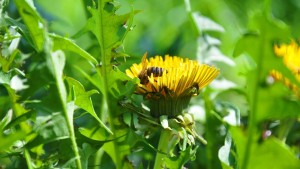 Pick the dandelion greens from your own backyard, wash them, boil them to make tea, eat them in salads or sauté them. It is a liver cleanser and bile flow stimulator. It is a useful food in spring when the liver is working hard to detoxify deep tissues and fat cells.
Pick the dandelion greens from your own backyard, wash them, boil them to make tea, eat them in salads or sauté them. It is a liver cleanser and bile flow stimulator. It is a useful food in spring when the liver is working hard to detoxify deep tissues and fat cells.
Dandelion is a member of the sunflower family harvested in the spring and summer. The dandelion is high in vitamin A and potassium.
The young greens can be eaten raw in a salad, alone or mixed with other spring greens. The older greens should be parboiled to cut the bitter flavor.
9. Turmeric
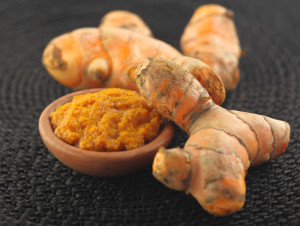 This spring-harvested bitter rhizome naturally scrubs any excess mucus left over from the winter off the intestinal wall. It stimulates liver function, bile flow and blood purification. Turmeric helps us avoid spring colds by keeping our immune system strong.
This spring-harvested bitter rhizome naturally scrubs any excess mucus left over from the winter off the intestinal wall. It stimulates liver function, bile flow and blood purification. Turmeric helps us avoid spring colds by keeping our immune system strong.
You will find fresh turmeric in stores this time of year. Add it to curry dishes. Simmer in water or nut milk for a healthy morning beverage. Add a little fresh pepper, studies show it aids in the absorption of curcumin, the active ingredient in turmeric.
10. Nettles
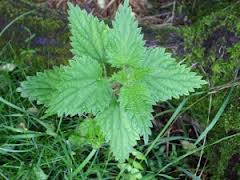 If you are lucky enough to find stinging nettles in the woods or farmers market grab them. This highly nutritious, prickly plant is often used as a spring tonic. It’s a natural herb that removes metabolic wastes and is gentle and stimulating on the lymph system, promoting easy excretion of toxins through the kidneys.
If you are lucky enough to find stinging nettles in the woods or farmers market grab them. This highly nutritious, prickly plant is often used as a spring tonic. It’s a natural herb that removes metabolic wastes and is gentle and stimulating on the lymph system, promoting easy excretion of toxins through the kidneys.
Nettles have anti-inflammatory qualities affecting enzymes in allergic reactions preventing hay fever.
A word of caution, nettle leaves come with little hairs that will sting you if handled improperly but once you cook them they lose their sting. Use in recipes as you would spinach. Add them to soups or stews. My favorite is Stinging Nettle Pesto. I will post a recipe as soon as I can get my hands on some nettles this year.
Please support your microbiome as we transition from winter to spring. Enjoy these vegetables to eat well and enjoy life.
Until next time, have a fantastic day. I hope this information makes you healthier and happier. Please leave a comment below. I always love hearing about your health journey and your thoughts and feedback.
Much love,
Ingrid
